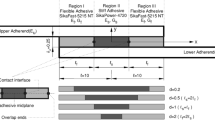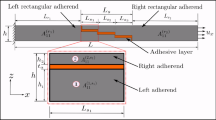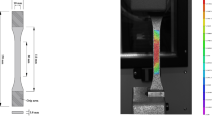Abstract
The aim of this research is to study the effect of a break in the laminated composite adherends on stress distribution in the adhesively single-lap joint with viscoelastic adhesive and matrix. The proposed model involves two adherends with E-glass fibers and poly-methyl-methacrylate matrix that have been adhered to each other by phenolic-epoxy resin. The equilibrium equations that are based on shear-lag theory have been derived in the Laplace domain, and the governing differential equations of the model have been derived analytically in the Laplace domain. A numerical inverse Laplace transform, which is called Gaver–Stehfest method, has been used to extract desired results in the time domain. The results obtained at the initial time completely matched with the results of elastic solution. Also, a comparison between results obtained from the analytical and finite element models show a relatively good match. The results show that viscoelastic behavior decreases the peak of stress near the break. Finally, the effect of size and location of the break, as well as volume fraction of fibers, on the stress distribution in the adhesive layer is fully investigated.























Similar content being viewed by others
Abbreviations
- \(A_{f}\) :
-
Cross-sectional area of each fiber
- \(E_{f}\) :
-
Elastic modulus of each fiber
- \(f\) :
-
First broken fiber in layers which are broken in the upper adherend
- \(g\) :
-
Total number of cut layers
- \(G_{a}\) :
-
Shear modulus of the adhesive layer
- \(G_{m}\) :
-
Shear modulus of matrix
- \(h\) :
-
Adhesive thickness
- \(l\) :
-
Number of first broken layer
- \(m\) :
-
Layer number in the top adherend
- \(M\) :
-
Total number of layers in the top adherend
- \(n\) :
-
Filament number in each layer of the top adherend
- \(N\) :
-
Total number of filaments in each layer of the top adherend
- \(\hat{p}\) :
-
Load in fiber in Laplace domain
- \(p\) :
-
Filament number in each layer of the bottom adherend
- \(q\) :
-
Layer number in the bottom adherend
- \(Q\) :
-
Total number of layers in the bottom adherend
- \(r\) :
-
Total number of broken fibers in each layer
- \(\widehat{R}\) :
-
Eigenvector of matrix \(\mathbf{L}\)
- \(s\) :
-
Laplacian variable
- \(t\) :
-
Time
- \(t_{f}\) :
-
Width of fiber cross-section
- \(t_{m}\) :
-
Thickness of matrix bays
- \(T_{n}\) :
-
Equivalent transferred shear force on the \(n\)th fiber from the adjacent matrices
- \(u\) :
-
Displacement of each fiber along the \(x\) direction
- \(v\) :
-
Displacement of the matrix along the \(y\) direction
- \(V_{f}\) :
-
Volume fraction of fibers in laminate
- \(w\) :
-
Displacement of the matrix along the \(z\) direction
- \(\alpha\) :
-
Boundary associated with break plane in the overlap
- \(\beta\) :
-
Boundary associated with right end of the overlap
- \(\gamma\) :
-
Boundary associated with left end of the overlap
- \(\lambda\) :
-
Eigenvalue of matrix \(\mathbf{L}\)
- \(\tau_{zx}^{a}\) :
-
Shear stress exerted by the adhesive layer to the fiber
- \(\tau_{zx}^{\prime a}\) :
-
Shear stress exerted by the adhesive layer to the surrounding matrix
- \(\tau_{zx}\) :
-
Shear stress exerted by surrounding matrix to the fiber
- \(\tau_{yx}\) :
-
Shear stress exerted by surrounding matrix to the fiber
References
Abate, J., Whitt, W.: A unified framework for numerically inverting Laplace transforms. INFORMS J. Comput. 18, 408–421 (2006)
Andrianov, I.V., Topol, H., Weichert, D.: Load transfer in fibre-reinforced composites with viscoelastic matrix: an analytical study. Arch. Appl. Mech. 79(11), 999–1007 (2009). doi:10.1007/s00419-008-0265-y
Banea, M.D., da Silva, L.F.M.: Adhesively bonded joints in composite materials: an overview. J. Mater. Des. Appl. 223(1), 1–18 (2009). doi:10.1243/14644207jmda219
Brinson, H.F., Brinson, L.C.: An Introduction to Polymer Engineering Science & Viscoelasticity. Springer, Berlin (2008)
Budhe, S., Banea, M.D., de Barros, S., da Silva, L.F.M.: An updated review of adhesively bonded joints in composite materials. Int. J. Adhes. Adhes. 72, 30–42 (2017)
Casas-Rodriguez, J.P., Ashcroft, I.A., Silberschmidt, V.V.: Damage in adhesively bonded CFRP joints: sinusoidal and impact-fatigue. Compos. Sci. Technol. 68(13), 2663–2670 (2008). doi:10.1016/j.compscitech.2008.04.030
Chadegani, A., Batra, R.C.: Analysis of adhesive-bonded single-lap joint with an interfacial crack and a void. Int. J. Adhes. Adhes. 31(6), 455–465 (2011). doi:10.1016/j.ijadhadh.2011.02.006
Chen, Z., Adams, R.D., da Silva, L.F.M.: The use of the J-integral vector to analyse adhesive bonds with and without a crack. Int. J. Adhes. Adhes. 31(1), 48–55 (2011). doi:10.1016/j.ijadhadh.2010.11.005
da Silva, L.F.M., das Neves, P.J.C., Adams, R.D., Spelt, J.K.: Analytical models of adhesively bonded joints—part I: literature survey. Int. J. Adhes. Adhes. 29(3), 319–330 (2009a). doi:10.1016/j.ijadhadh.2008.06.005
da Silva, L.F.M., das Neves, P.J.C., Adams, R.D., Wang, A., Spelt, J.K.: Analytical models of adhesively bonded joints—part II: comparative study. Int. J. Adhes. Adhes. 29(3), 331–341 (2009b). doi:10.1016/j.ijadhadh.2008.06.007
Fotsing, E.R., Miron, F., Eury, Y., Ross, A., Ruiz, E.: Bonding analysis of carbon/epoxy composites with viscoelastic acrylic adhesive. Composites part B. Engineering 43(5), 2087–2093 (2012). doi:10.1016/j.compositesb.2012.03.009
Groth, H.L.: Viscoelastic and viscoplastic stress analysis of adhesive joints. Int. J. Adhes. Adhes. 10(3), 207–213 (1990). doi:10.1016/0143-7496(90)90105-7
Her, S.C.: Stress analysis of adhesively-bonded lap joints. Compos. Struct. 47(1–4), 673–678 (1999). doi:10.1016/S0263-8223(00)00052-0
Kim, W.-S., Lee, J.-J.: Fracture characterization of interfacial cracks with frictional contact of the crack surfaces to predict failures in adhesive-bonded joints. Eng. Fract. Mech. 76(12), 1785–1799 (2009). doi:10.1016/j.engfracmech.2009.03.014
Luo, Q., Tong, L.: Analytical solutions for adhesive composite joints considering large deflection and transverse shear deformation in adherends. Int. J. Solids Struct. 45(22–23), 5914–5935 (2008). doi:10.1016/j.ijsolstr.2008.07.001
Luo, Q., Tong, L.: Analytical solutions for nonlinear analysis of composite single-lap adhesive joints. Int. J. Adhes. Adhes. 29(2), 144–154 (2009). doi:10.1016/j.ijadhadh.2008.01.007
Montella, C.: LSV modelling of electrochemical systems through numerical inversion of Laplace transforms. I—The GS–LSV algorithm. J. Electroanal. Chem. 614(1–2), 121–130 (2008). doi:10.1016/j.jelechem.2007.11.010
Montella, C., Diard, J.P.: New approach of electrochemical systems dynamics in the time-domain under small-signal conditions. I. A family of algorithms based on numerical inversion of Laplace transforms. J. Electroanal. Chem. 623(1), 29–40 (2008). doi:10.1016/j.jelechem.2008.06.015
Neto, J.A.B.P., Campilho, R.D.S.G., da Silva, L.F.M.: Parametric study of adhesive joints with composites. Int. J. Adhes. Adhes. 37(0), 96–101 (2012). doi:10.1016/j.ijadhadh.2012.01.019
Reza, A., Shishesaz, M., Naderan-Tahan, K.: The effect of viscoelasticity on creep behavior of double-lap adhesively bonded joints. Lat. Am. J. Solids Struct. 11(1), 35–50 (2014). doi:10.1590/S1679-78252014000100003
Ribeiro, F.L., Borges, L., d’Almeida, J.R.M.: Numerical stress analysis of carbon-fibre-reinforced epoxy composite single-lap joints. Int. J. Adhes. Adhes. 31(5), 331–337 (2011). doi:10.1016/j.ijadhadh.2011.01.008
Sato, C.: Stress estimation of joints having adherends with different curvatures bonded with viscoelastic adhesives. Int. J. Adhes. Adhes. 31(5), 315–321 (2011). doi:10.1016/j.ijadhadh.2011.01.007
Shenoy, V., Ashcroft, I.A., Critchlow, G.W., Crocombe, A.D., Abdel Wahab, M.M.: An investigation into the crack initiation and propagation behaviour of bonded single-lap joints using backface strain. Int. J. Adhes. Adhes. 29(4), 361–371 (2009). doi:10.1016/j.ijadhadh.2008.07.008
Shishesaz, M., Reza, A.: The effect of viscoelasticity of adhesives on shear stress distribution in a double-lap joint using analytical method. J. Adhes. Sci. Technol. 27(20), 2233–2250 (2013a). doi:10.1080/01694243.2013.769085
Shishesaz, M., Reza, A.: The effect of viscoelasticity of polymeric adhesives on shear stress distribution in a single-lap joint. J. Adhes. 89(11), 859–880 (2013b). doi:10.1080/00218464.2012.750581
Shishesaz, M., Reza, A., Daniali, M.: Stress distribution in single lap joints with a cracked composite adherend—part I: single lamina adherends. J. Adhes. 90(11), 912–931 (2013a). doi:10.1080/00218464.2013.852083
Shishesaz, M., Reza, A., Daniali, M.: Stress distribution in single lap joints with a cracked composite adherend—part II: laminated adherends. J. Adhes. 90(12), 933–954 (2013b). doi:10.1080/00218464.2013.852084
Sørensen, B.F., Goutianos, S., Jacobsen, T.K.: Strength scaling of adhesive joints in polymer–matrix composites. Int. J. Solids Struct. 46(3–4), 741–761 (2009). doi:10.1016/j.ijsolstr.2008.09.024
Tsai, M.Y., Morton, J.: An investigation into the stresses in double-lap adhesive joints with laminated composite adherends. Int. J. Solids Struct. 47(24), 3317–3325 (2010). doi:10.1016/j.ijsolstr.2010.08.011
Tyberg, C.S., Bergeron, K., Sankarapandian, M., Shih, P., Loos, A.C., Dillard, D.A., McGrath, J.E., Riffle, J.S., Sorathia, U.: Structure–property relationships of void-free phenolic–epoxy matrix materials. Polymer 41(13), 5053–5062 (2000). doi:10.1016/s0032-3861(99)00574-1
Wang, J., Qin, Q.H., Kang, Y.L., Li, X.Q., Rong, Q.Q.: Viscoelastic adhesive interfacial model and experimental characterization for interfacial parameters. Mech. Mater. 42(5), 537–547 (2010). doi:10.1016/j.mechmat.2010.03.002
Zangenberg, J., Poulsen, S.H., Bagger, A., Stang, H., Olesen, J.F.: Embedded adhesive connection for laminated glass plates. Int. J. Adhes. Adhes. 34(0), 68–79 (2012). doi:10.1016/j.ijadhadh.2012.01.003
Author information
Authors and Affiliations
Corresponding author
Appendix
Appendix
\(\mathbf{L}(s)\) is defined as
where \(\mathbf{0}_{N\times N}\) is a zero matrix, and \(\mathbf{L}_{N\times N}^{3}\), \(\mathbf{L}_{N\times N}^{4}\), \(\mathbf{L}_{N\times N}^{5}\), and \(\mathbf{L}_{N\times N}^{6}\) are defined as follows:
where \(\chi_{1}\) to \(\chi_{6}\) are defined as
And also \(\varphi_{1}\), \(\varphi_{2}\), \(\varphi_{3}\) and \(\psi\) are given by
Also
\(\mathbf{L}_{N\times N}^{7}\) is defined as
Rights and permissions
About this article
Cite this article
Reza, A., Shishesaz, M. The effect of viscoelasticity on the stress distribution of adhesively single-lap joint with an internal break in the composite adherends. Mech Time-Depend Mater 22, 373–399 (2018). https://doi.org/10.1007/s11043-017-9362-z
Received:
Accepted:
Published:
Issue Date:
DOI: https://doi.org/10.1007/s11043-017-9362-z




